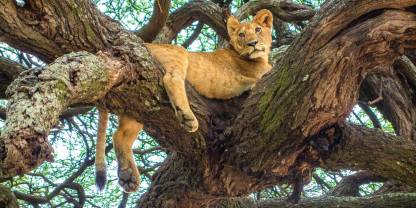Average Expert Rating
Rating Breakdown
Write a User ReviewA vision in pink
Lake Manyara is an unassuming yet attractive park that in truth deserves more time and attention - most people dash through en route to Ngorongoro Crater. Two-thirds of it is taken up by the lake itself and the rest is squeezed between the lake shores and the red cliffs of the Manyara Escarpment of the Great Rift Valley. As such, its varied habitat attracts myriad birdlife and the lake becomes a blanket of pink when thousands of flamingoes descend upon it on their migration. It’s well-known for its huge population of baboons – they seem to be everywhere here. But it’s perhaps better known for its far smaller numbers of tree-climbing lion, a rare but beautiful sight. I saw a lioness and three young cubs perched quite precariously in an acacia tree on my last visit and would have stayed to watch them for hours were it not for the tsetse flies that can make life quite uncomfortable. One school of thought is that the lions climb the trees to avoid the flies!
Elephants, flamingos & Rift Valley vistas
Manyara is small, scenic and, at first glance, almost completely dominated by the shallow expanses of Lake Manyara. Yet, despite the lake’s reach (or perhaps because of it), Manyara has an impressive diversity of habitats and one of the highest biomass densities of large mammals in the world. Hippos, elephants, zebras, giraffes and buffalo are all frequently spotted, and with luck, you may see some of the tree-climbing lions for which Manyara is famed. Among the things I like best about the greater Manyara area are the wide views down over the lake from the top of the Rift Valley escarpment.
Many Northern circuit safari itineraries relegate Manyara to a quick day visit. If your time is limited, this may be ‘enough’ in favour of additional time in the more action-packed Serengeti or Ngorongoro Crater. However, if you are a repeat safari-goer, or if you are interested in birding, then plan on at least a night here.
Pretty in Pink
Manyara has also become known for its leopards and tree-climbing lions, though I had no luck with either and was told by my guide that both were very rare sightings here. I was also informed that in fact lions have been seen climbing and lounging about in trees in many of Tanzania’s parks. Easier to spot were the large numbers of baboons, elephants and hippos.
Sadly the small size of the park and its proximity to the two biggest stalwarts on the Northern
Read more
Circuit mean that Manyara can get rather busy. But it’s still worth at least a morning’s game drive and a few landscape pictures.Lake of Elephants
However, there was no escaping the crowds. The park is small, and attracts a high concentration of day visitors passing through en route to the greater attractions of the Serengeti. Many of these visitors don’t have time to venture far into the park so cluster near the entrance, which can mean an unseemly build-up of traffic in this area. It’s a shame, because time to explore deeper into the park would, I’m sure, be rewarding.
I saw the famous elephants, of which there were plenty, plus enormous numbers of baboons, and forest species such as bushbuck and colobus
Read more
monkeys. Like most day visitors, I missed the famous tree-climbing lions, which generally require more time and a trip deeper into the park. A stay inside the park would also allow canoeing and night drives, which are both excellent options.It’s a lovely destination, and rich in wildlife, but suffers from its position as the gateway to the ‘Northern circuit’, which means that for many visitors it will always serve as an introduction to – and subsequently poor comparison with – the Serengeti.
Night drives, bush walks, and dramatic scenery
Read more
Tanzania. The best thing about the park is the variety of activities available. Night drives, bush walks, and canoe safaris (lake levels permitting) give the typical safari itinerary a little variety.Manyara: Among the Elephants (and Flamingos)
Manyara’s two best features are the appealing ‘Lost World’ feeling of the towering cliffs and wheeling flocks of birds, and the beauty of the lake. I loved seeing buffalo grazing in the emerald-green swamp grass, and the impressively large flocks of flamingos and pelicans on the lake. I also love Manyara’s abundance of elephants, which were studied intensively by famous biologist Iain Douglas-Hamilton in the 1970s. As a result, they’re well accustomed to human visitors and tolerate close approaches by people. The classic book ‘Among the Elephants’ by Douglas-Hamilton is one of my favourites, and essential reading if you want to get the most out of your visit.
Manyara is also famous for tree-climbing lions, but be warned – lions can be frustratingly hard to find here either in or out of the trees, especially if you just come in for one or two days. On my last visit, though, a night drive yielded no less than THREE leopard sightings, which more than made up for the lack of arboreal cats in the daytime.

